
GEOMETRIAE DEDICATA
Scope & Guideline
Connecting Ideas Across the Geometric Landscape
Introduction
Aims and Scopes
- Differential Geometry and Riemannian Geometry:
The journal publishes articles exploring the properties and structures of differentiable manifolds, including studies of curvature, geodesics, and metrics, often employing Riemannian techniques. - Algebraic Geometry and Moduli Spaces:
Research on algebraic varieties, particularly moduli spaces, is a prominent theme, with a focus on their geometric structures and applications in other areas of mathematics. - Topology and Geometric Group Theory:
The journal covers topics in topology, including the study of manifolds, homotopy theory, and geometric group theory, emphasizing the interplay between algebraic and geometric methods. - Complex Geometry and Kähler Metrics:
Significant emphasis is placed on complex manifolds, Kähler metrics, and related structures, reflecting ongoing interests in both theoretical and applied aspects of complex geometry. - Dynamical Systems and Ergodic Theory:
Papers examining dynamical systems, particularly in geometric contexts, and their ergodic properties are also common, showcasing the journal's commitment to exploring motion and transformations within geometric frameworks.
Trending and Emerging
- Non-Positive Curvature and Metric Geometry:
A growing focus on non-positively curved spaces and their geometric properties is evident, highlighting their relevance in various mathematical contexts, including geometric group theory. - Geometric Group Theory:
The study of groups through geometric lenses is on the rise, with increased attention to their actions on spaces and implications for topological properties. - Interplay Between Geometry and Physics:
Research exploring the connections between geometric structures and physical theories, particularly in areas such as string theory and general relativity, is gaining traction, reflecting interdisciplinary interests. - Higher-Dimensional Geometry and Topological Methods:
There is an emerging trend towards higher-dimensional geometrical constructs and topological approaches, indicating a broadening of the journal's scope into more abstract settings. - Geometric Structures on Manifolds:
Papers examining various geometric structures on manifolds, including connections to algebraic topology and representation theory, are increasingly prevalent, showcasing the journal's commitment to contemporary issues in geometry.
Declining or Waning
- Classical Analysis in Geometry:
There has been a noticeable decline in papers focusing on classical analysis techniques applied to geometric problems, suggesting a shift towards more algebraic and topological methods. - Low-Dimensional Topology:
Research in low-dimensional topology, particularly studies related to 3-manifolds and knot theory, appears to be waning, with fewer submissions addressing these traditional topics. - Symplectic Geometry:
Symplectic geometry, once a vibrant area of interest, has seen fewer contributions, indicating a potential transition towards other geometric structures over the past few years.
Similar Journals
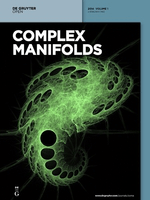
Complex Manifolds
Fostering Innovation in Complex ManifoldsComplex Manifolds is a distinguished open access journal published by DE GRUYTER POLAND SP Z O O, focusing on the rich interplay between geometry and topology. Since its inception in 2014, this journal has become a pivotal platform for researchers, professionals, and students, fostering the dissemination of high-quality research in complex geometry. With an impact factor reflective of its Q2 ranking in the Geometry and Topology category, it currently holds a commendable place in the Scopus rankings (Rank #53/106, 50th percentile), making it an essential resource for those in mathematical sciences. The journal is committed to advancing knowledge and innovation in its field, and its open access model ensures that research findings are readily available to a global audience. The scope of the journal encompasses various aspects of complex manifolds, promoting interdisciplinary collaboration and dynamic discourse among scholars. Published in Warsaw, Poland, Complex Manifolds is poised to continue contributing valuable insights to the mathematical community through 2024 and beyond.
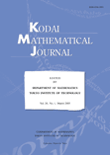
Kodai Mathematical Journal
Empowering Researchers with Rigorous Mathematical DiscourseKodai Mathematical Journal is a distinguished publication dedicated to advancing the field of mathematics, particularly in miscellaneous areas. Established in 1949, this esteemed journal has been a reputable source for researchers and practitioners who seek to contribute to the rich landscape of mathematical knowledge. Published by KINOKUNIYA CO LTD, the journal is based in the academic environment of Tokyo Institute of Technology and serves a global audience with rigorous and insightful research articles. Despite its current Q3 quartile ranking in the Scopus Mathematics category, which reflects its niche but impactful contributions, the journal is poised for growth; the convergence of traditional and novel mathematical techniques promises to enhance its relevance further. Researchers, professionals, and students are encouraged to engage with the rich content of the journal, aimed at fostering collaboration and nurturing innovation in the mathematical community. While currently not available as Open Access, Kodai Mathematical Journal remains a critical resource for those passionate about mathematics and its applications.
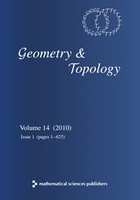
GEOMETRY & TOPOLOGY
Unraveling the Intricacies of Space and ShapeGeometry & Topology is a leading journal in the field of mathematics, focusing on the intricate relationships between geometric structures and topological spaces. Published by Geometry & Topology Publications in the United Kingdom, this prestigious journal boasts an impressive ranking, placing it in the Q1 quartile for Geometry and Topology as of 2023, with a notable Scopus rank of #13 out of 106, indicating its significant impact within the discipline (88th percentile). With publication years spanning from 1997 to 2024, the journal serves as a vital platform for disseminating high-quality research, fostering advances in both theoretical and applied aspects of the field. While it does not currently operate under an Open Access model, it nevertheless attracts the attention of a diverse audience, including researchers, academics, and students eager to explore innovative methodologies and findings in geometry and topology. The journal’s commitment to excellence makes it an essential resource for anyone passionate about mathematical research.
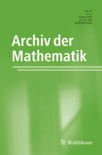
ARCHIV DER MATHEMATIK
Advancing Mathematical Frontiers Since 1948ARCHIV DER MATHEMATIK is a distinguished journal published by SPRINGER BASEL AG, renowned for its contributions to the field of mathematics. Established in 1948 and continuing its legacy through to 2024, the journal provides a platform for innovative research and scholarly articles that push the boundaries of mathematical theory and application. With an ISSN of 0003-889X and an E-ISSN of 1420-8938, it holds a reputable position within the academic community, reflected by its Q2 ranking in the 2023 Mathematics (Miscellaneous) category. Despite not being an open access publication, ARCHIV DER MATHEMATIK remains accessible to a global audience through various databases, ensuring the dissemination of high-quality research. The journal’s commitment to enhancing mathematical discourse makes it an essential resource for researchers, professionals, and students seeking to expand their understanding of this vital discipline.
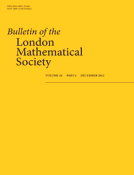
BULLETIN OF THE LONDON MATHEMATICAL SOCIETY
Championing Scholarly Discourse in the Mathematical SciencesThe BULLETIN OF THE LONDON MATHEMATICAL SOCIETY, published by Wiley, is a distinguished journal that serves as a vital resource in the field of mathematics. With its ISSN 0024-6093 and E-ISSN 1469-2120, this journal has consistently provided a platform for innovative research and scholarly discourse since its inception in 1969. Recognized for its quality, it currently holds an impressive Q1 ranking in the mathematics category, a testament to its significance in disseminating influential findings and trends in the mathematical sciences. Researchers and practitioners can rely on the BULLETIN for its comprehensive coverage of both theoretical and applied mathematics, which caters to a diverse audience ranging from professionals to students alike. Though it does not currently offer Open Access options, its articles can be accessed through institutional subscriptions, ensuring that significant works reach the academic community effectively. With contributions that span over five decades, the journal continues to shape mathematical research and inspire future advancements in the discipline.
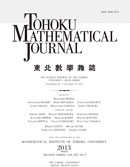
TOHOKU MATHEMATICAL JOURNAL
Championing Excellence in Peer-Reviewed MathematicsTOHOKU MATHEMATICAL JOURNAL, published by TOHOKU UNIVERSITY, is a distinguished academic journal committed to the advancement of mathematical research. Established in 1949, the journal has sustained a long-standing tradition of disseminating high-quality, peer-reviewed articles that contribute significantly to various branches of mathematics. With its scope encompassing a broad range of topics within the field, TOHOKU MATHEMATICAL JOURNAL aims to foster intellectual exchange and innovation among mathematicians worldwide. Though currently not an open-access publication, it is indexed in Scopus, holding a respectable Q2 ranking in the miscellaneous mathematics category as of 2023, which signifies its relevance and influence in the academic community. Researchers, professionals, and students alike will find valuable insights and contemporary developments that reflect the journal's dedication to excellence in mathematical scholarship.

Selecta Mathematica-New Series
Empowering Research Through Rigorous Peer Review.Selecta Mathematica-New Series is a premier academic journal published by Springer International Publishing AG, based in Switzerland. With an impressive impact in the fields of Mathematics and Physics, it is recognized in the Q1 category for both Mathematics (Miscellaneous) and Physics and Astronomy (Miscellaneous) as of 2023. Established in 1995, the journal provides a platform for rigorous peer-reviewed research, facilitating the dissemination of groundbreaking findings and theoretical advancements through its converged publication years up to 2024. Researchers and scholars seeking to stay at the forefront of mathematical and physical sciences will benefit from the journal's diverse scope and high-impact articles. Although it does not operate under an open-access model, Selecta Mathematica-New Series remains a vital resource for building knowledge and fostering collaboration among professionals and students engaged in these dynamic fields. Access to its content is essential for those aiming to deepen their understanding and contribute to the ongoing dialogue within the scientific community.

Cambridge Journal of Mathematics
Advancing Mathematical Frontiers with Every IssueCambridge Journal of Mathematics, published by INT PRESS BOSTON, INC, is a premier platform for the dissemination of cutting-edge research in the field of mathematics. With an ISSN of 2168-0930 and E-ISSN 2168-0949, this journal stands out in a competitive academic landscape, currently ranked #58 out of 399 in General Mathematics, placing it in the top 15% within its category according to Scopus metrics. The journal serves as a vital resource for researchers, professionals, and students alike, aiming to foster groundbreaking mathematical inquiries and foster collaboration across disciplines. Published from 2020 to 2024, the Cambridge Journal of Mathematics is committed to maintaining high standards of scholarship, making it an essential read for those who are passionate about advancing mathematical knowledge and its applications.

Journal of Homotopy and Related Structures
Bridging Disciplines Through Innovative ResearchJournal of Homotopy and Related Structures is a distinguished academic journal published by Springer Heidelberg, specializing in the fields of algebra, number theory, geometry, and topology. With a focus on the intricate relationships and structures within these disciplines, the journal aims to facilitate the dissemination of original research and provide a platform for scholarly exchange among mathematicians. Since its inception in 2012, the journal has positioned itself in the Q2 category for both Algebra and Number Theory and Geometry and Topology in 2023, reflecting its growing influence and commitment to high-quality publications. Although it operates under a subscription model, the research published in this journal is highly cited, contributing to its notable rankings—#57 in Geometry and Topology and #65 in Algebra and Number Theory on the Scopus index. This journal is an essential resource for researchers, professionals, and students who wish to stay updated with the latest advancements and trends in homotopy theory and related mathematical structures.

TRANSFORMATION GROUPS
Navigating the Complexities of Algebraic and Geometric TransformationsTRANSFORMATION GROUPS, published by Springer Birkhäuser, is a leading academic journal specializing in the fields of algebra, geometry, and topology. With its ISSN 1083-4362 and E-ISSN 1531-586X, the journal has established itself as an essential resource for researchers and academicians, achieving a remarkable Impact Factor and ranking in prestigious categories: Q1 in Algebra and Number Theory and Q2 in Geometry and Topology as of 2023. Over its history from 1997 to 2024, TRANSFORMATION GROUPS has delivered cutting-edge research and innovative insights, currently holding Scopus rankings of #40/119 in Algebra and Number Theory and #38/106 in Geometry and Topology. This journal caters to those seeking to enhance their understanding of mathematical transformations and their applications, making it a vital platform for scholarly discourse within the mathematical community.